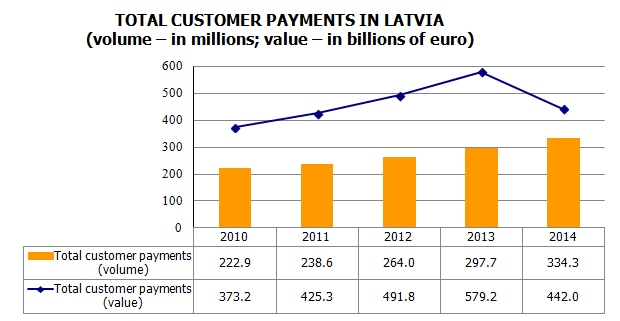
The trend observed in Latvia in 2013 continued also last year – card payments (191.0 million) were the most frequently used payment instrument, amounting to 57.1% of the total volume of customer payments. The volume of customer credit transfers represented 138.3 million or 41.4% of total customer payments. Other payment instruments (direct debit, e-money and cheque payments) were relatively seldom used by the inhabitants.
Inhabitants increasingly used payment cards by making both face-to-face purchases in shops and other points of sale and remote card payments. Of card payments, 78.8% in terms of volume and 77.6% in terms of value were executed via POSs in shops and other points of sale. The volume and value of card payments made at POSs increased by 17.9% (to 150.5 million) and 5.5% (to 3.0 billion euro) respectively.
Remote card payments made on the internet (via Internet POSs) and via a phone expanded even at a faster pace. The volume of such payments grew by 69.0% and their value rose 2.1 times. Of card payments, remote card payments stood at 21.2% and 22.4% in terms of volume and value in 2014 respectively (15.8% and 12.5% in 2013 respectively), since the inhabitants of Latvia increasingly used e-commerce facilities, including online shopping.
In Latvia, 138.3 million credit transfers were executed in the amount of 437.9 billion euro in 2014. More than 90% of the above transfers were initiated electronically. Credit transfers made in euro amounted to 98.0% of the total volume of credit transfers and 41.5% of their value. Credit transfers executed in euro were predominantly SEPA credit transfers, since upon introducing the euro Latvia joined the SEPA area and used SEPA credit transfers.
At the end of 2014, 4.0 million customer settlement accounts were opened in Latvia. The number of customer settlement accounts shrank by 21.1% on account of the closure of the settlement accounts in lats after the introduction of the euro. The majority of customer settlement accounts (90.7%) were opened for settlement in euro. On average, 2.0 settlement accounts per capita were opened in Latvia.
The number of cards issued recorded a year-on-year decrease of 1.8% (to 2.3 million cards) at the end of 2014. Of the total number of payment cards, 78.3% (1.8 million) were debit cards, enabling settlement with the customer's funds, and 21.7% were credit cards and delayed debit cards (0.3 million or 13.0% and 0.2 million or 8.7% respectively), enabling the card holders to make settlement from the loan granted by credit institutions.
At the end of 2014, the number of ATMs declined by 9.3% (to 1068 ATMs) year-on-year. 537 ATMs per million inhabitants were available in Latvia at the end of 2014.
At the end of 2014, the number of POSs amounted to 28.5 thousand in Latvia (a 9.8% increase over the end of 2013). In Latvia, 14.3 thousand POSs were installed calculated per million inhabitants. In addition to conventional POSs, there were 3.4 thousand Internet POSs at the end of 2014.
A comprehensive report on the operation of interbank payment systems, development of payment instruments and other areas crucial for non-cash settlement is available on the website of Latvijas Banka https://www.bank.lv/en/statistics/payment-systems-statistics/latvia-s-payment-statistics.
